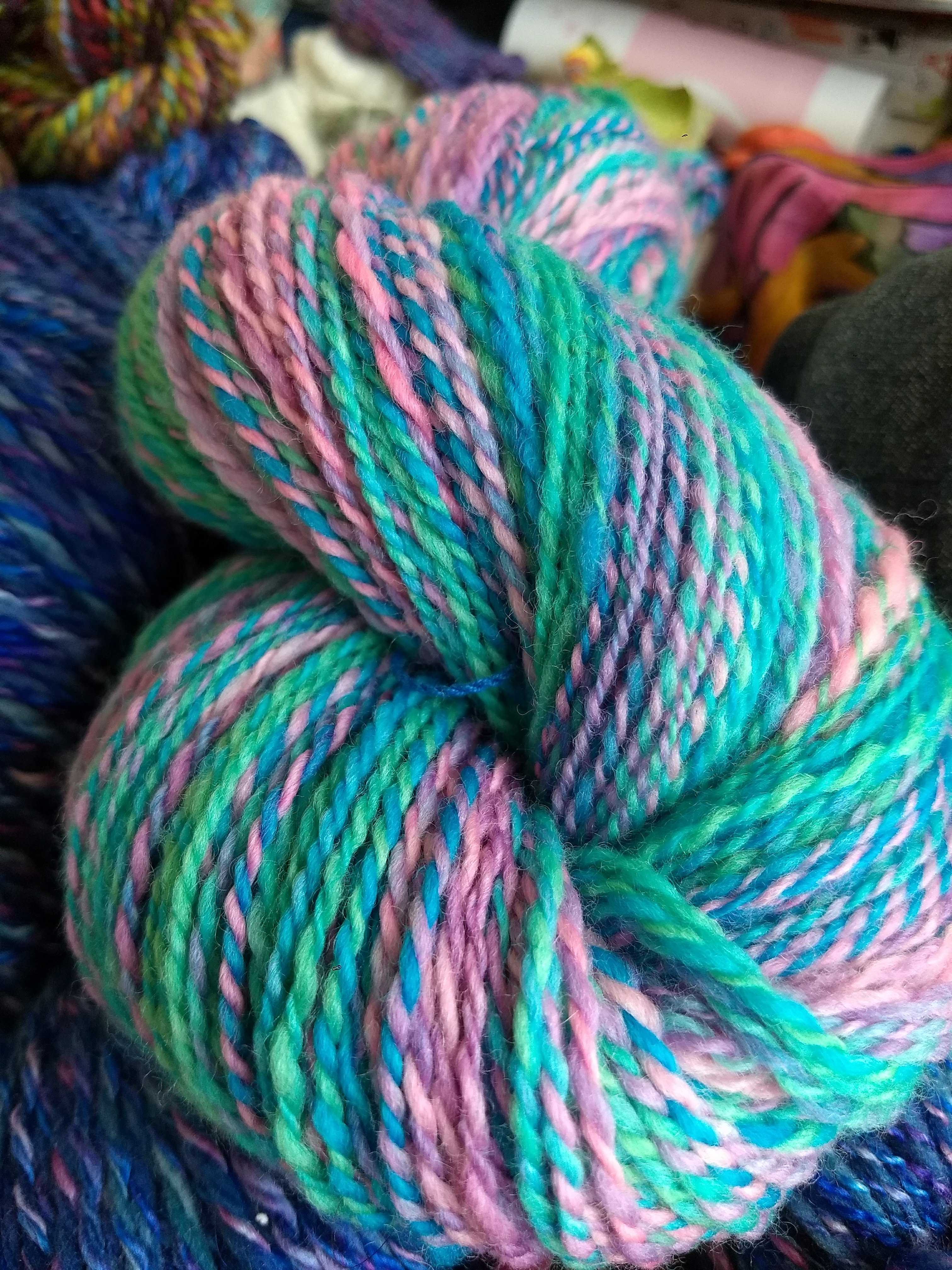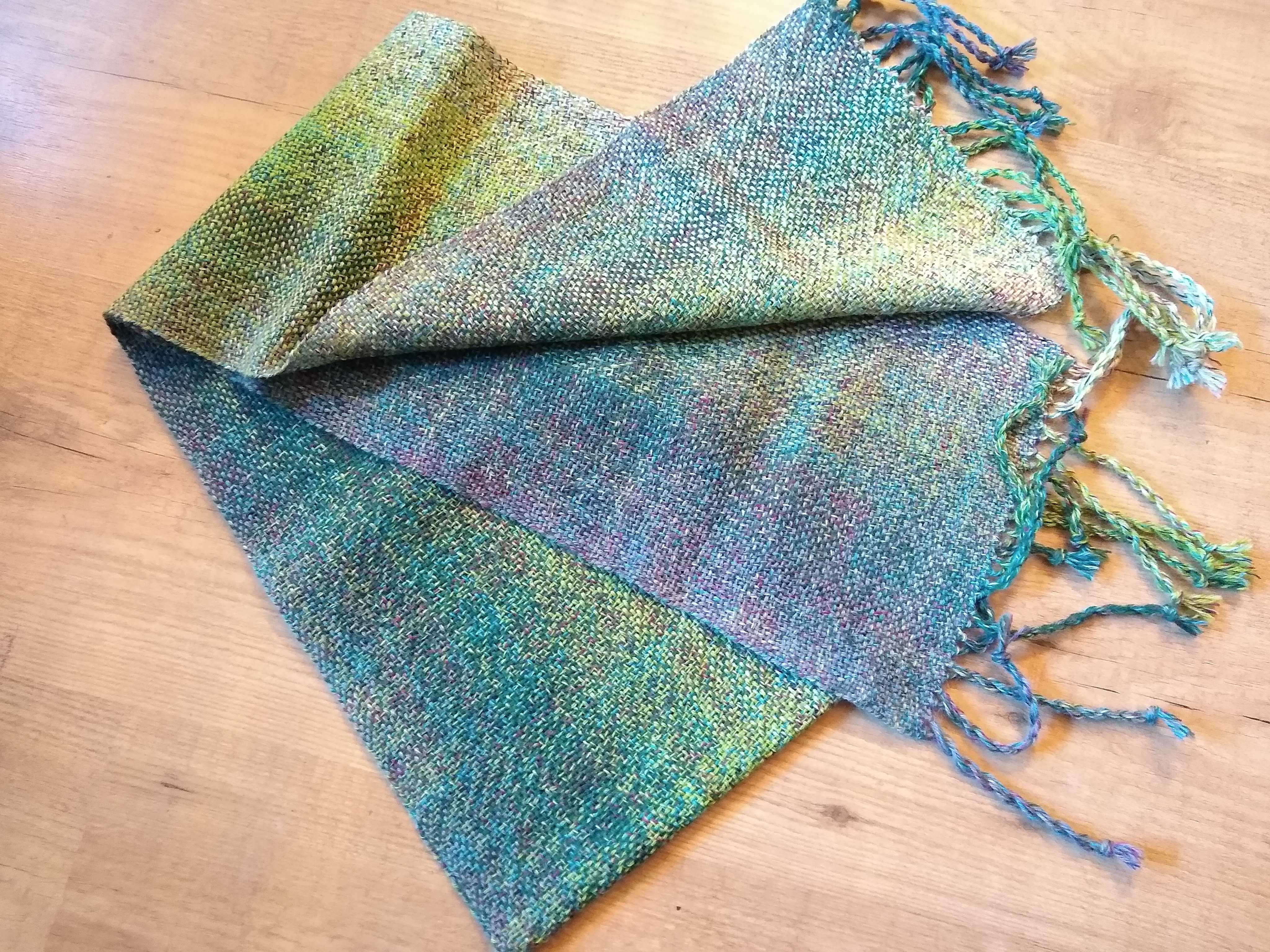ほふふさんへ
やっぱり国内でも不具合あるんですね。今日、横丁の方に一時的に入れましたが、再びログインを求められて、入ろうとしたら今度はエラー画面ではなく、小さなひつじさんが出てきて頭下げられました。なんて言ってたか忘れたけど、今はアクセスできませんみたいな感じでしたね。
気長に待って、再トライします。今のところできたのはお店をいくつか開店して座敷童子をクリックし、退治3回しただけです。
「顔選択」ですが、昔は顔がつけられたんですよ。廃止になったのか、使えなくなったのですが、まだそれがついてるのです。楽天も随分変わりました。広告が増えた。そして、いろいろな機能が削除されて、アフィリエイトなどを勧めてくるようになりました。以前アフィリエイトやってみたけれど、面倒でやめたんですよね。 (2024年01月27日 08時59分14秒)
やっぱり国内でも不具合あるんですね。今日、横丁の方に一時的に入れましたが、再びログインを求められて、入ろうとしたら今度はエラー画面ではなく、小さなひつじさんが出てきて頭下げられました。なんて言ってたか忘れたけど、今はアクセスできませんみたいな感じでしたね。
気長に待って、再トライします。今のところできたのはお店をいくつか開店して座敷童子をクリックし、退治3回しただけです。
「顔選択」ですが、昔は顔がつけられたんですよ。廃止になったのか、使えなくなったのですが、まだそれがついてるのです。楽天も随分変わりました。広告が増えた。そして、いろいろな機能が削除されて、アフィリエイトなどを勧めてくるようになりました。以前アフィリエイトやってみたけれど、面倒でやめたんですよね。 (2024年01月27日 08時59分14秒)
PR
X
Calendar
Freepage List
てぬきねこのてぬきレシピ集

ワイルドライス(北米)

キノア(ペルー)

レモン・ビスコッティ (イタリア)

ウィーンのお菓子(オーストリア)

芭蕉の葉とビビンカ(フィリピン)

芭蕉の包み蒸し(タイ・ラオス)

レンズ豆(アルメニア・日本)

いちごのシロップ(日本・北米)

ボスニア料理2種

ハンガリー料理2種

チョコレートビスコッティ(イタリア)

イスラエル料理4種
てぬきねこのハーブ・ヒント集

ローズマリー【子牛肉ロースト】

キャラウェイ・シード

キャラウェイシード【ねぎのパイ】

香菜 Cilantro

ソレルとアボカドのドレッシング

ヤロウのクレンジング

アップルミント・クーラー(Mint)

レモンバーム

スウィート・バジル

セージ

チャイヴ オイルとチーズ

タイム

月桂樹 ブーケガルニ

サフラン

たんぽぽのお酒

アカツメクサ

カモミール

西洋イラクサ

ラヴィッジ

リンデン 菩提樹の花

イタリアンパセリ

ナスタチウム(金連花)

タラゴン

オレガノ

ヤドリギ

ポットマリーゴールド

ニオイゼラニウム
スパイスの達人

五香粉
工事中
A Storm of Lasers
Comments
Keyword Search
▼キーワード検索
テーマ: 暮らしを楽しむ(388609)
カテゴリ: ファイバーアート・手紡ぎ・手織り
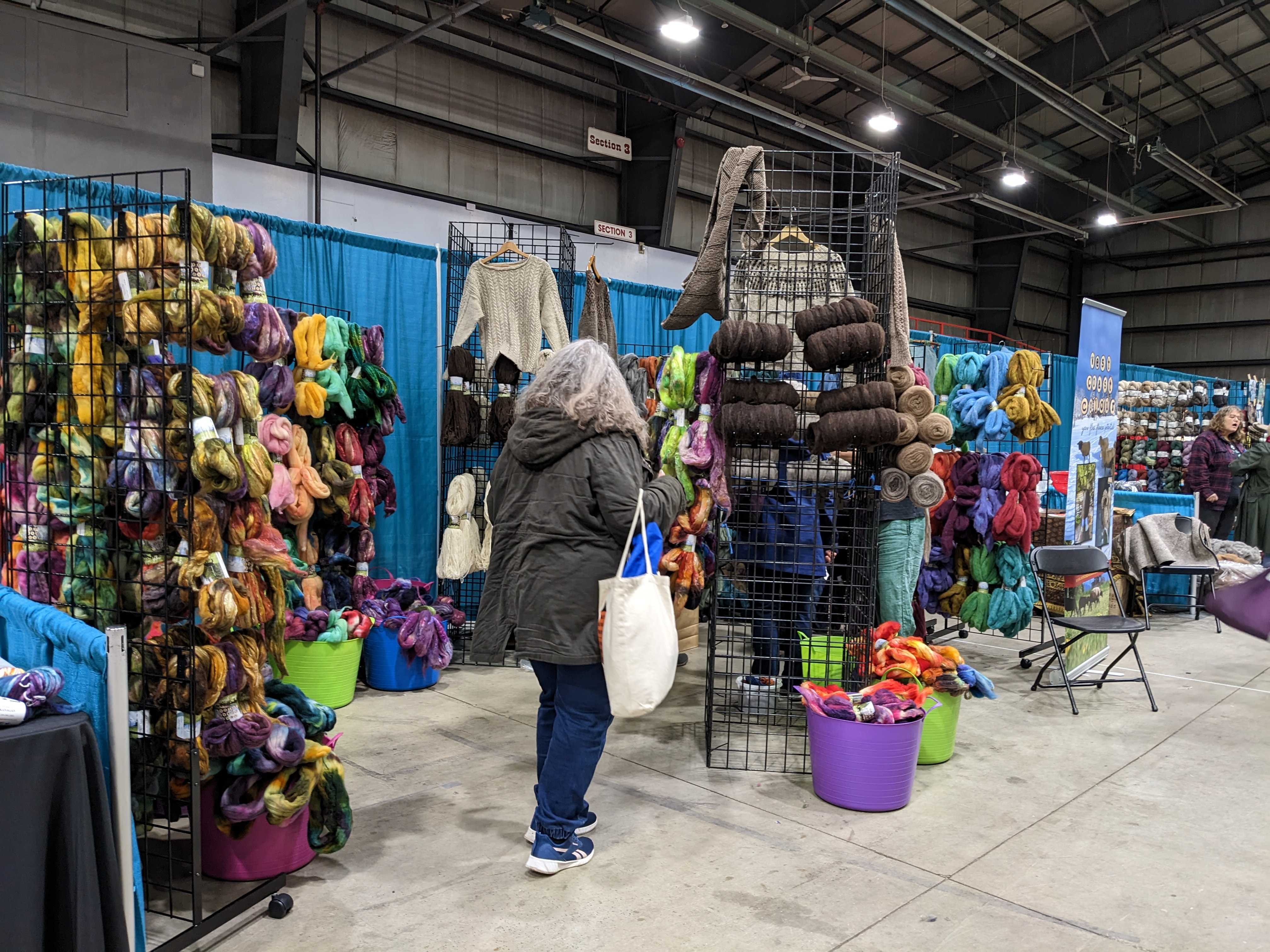
4年ぶりのFibres Westに行ってきました。
2020年、3月の中旬に全てセットアップも終わって、照明やその他の設備も整えて、開催日を二日後くらいに控えたとき、カナダ政府から大人数の集会の禁止令が出ました。開催者のPenelope Fibre Artsは大きな損害を被りました。出店者には返金をしないといけなかったし、出店者たちも遠方から陸路、空路でここまで来て、商品を並べる棚を作り、商品を並べ、飾り付けをし、全て整えてからそれをまた仕舞って家に帰らなければならなかったのですから、そちらも大きな損失でした。毎年のこの催しのためにいろいろと準備してきた人、これを楽しみにしてきたお客さん、遠くからきてもうホテルに入っていた人たちもいたと思います。
In 2020, in mid-March, when everything was set up, lights and other fixtures were in place, and the event was about two days away, the Canadian government issued a ban on large gatherings. Penelope Fibre Arts, the organizer of the event, suffered a significant loss. They had to give refunds to vendors. The vendors who came from far away by land and air, built shelves to display their goods, put up their goods, decorated, put everything in order, and had to put it all away again and go home. This was a significant loss for them as well. Many people had prepared for this annual event, customers had been looking forward to it, and some had come from far away and were already in their hotels.
多くの出店者は主催者に返金を求めず、次回に回して、と言ってくれたそうですが、それでも損失は相当のものだったと思います。今年開催できて本当によかったです。
Many of the vendors did not ask for refunds from the organizers and asked to put the funds aside for next time, but I think the loss was still considerable. I am so glad they were able to hold the event this year.
例年3月中旬に開くこの催しは、入場料を有料とし、冷やかしのお客さんが少なく、本当にファイバーアートをやりたい人たちばかりが集まるもので、出店者も一般受けはしない、技術のある人にしか扱えないような繊維などを全面的に出してくれるので、とても見応えがあります。
This event, which is usually held in mid-March, charges an admission fee and attracts only people who really want to do fibre arts, with few casual visitors. The stalls also display a full range of fibres that are not for the general public and can only be handled by those with the right skills. It is very worth seeing.
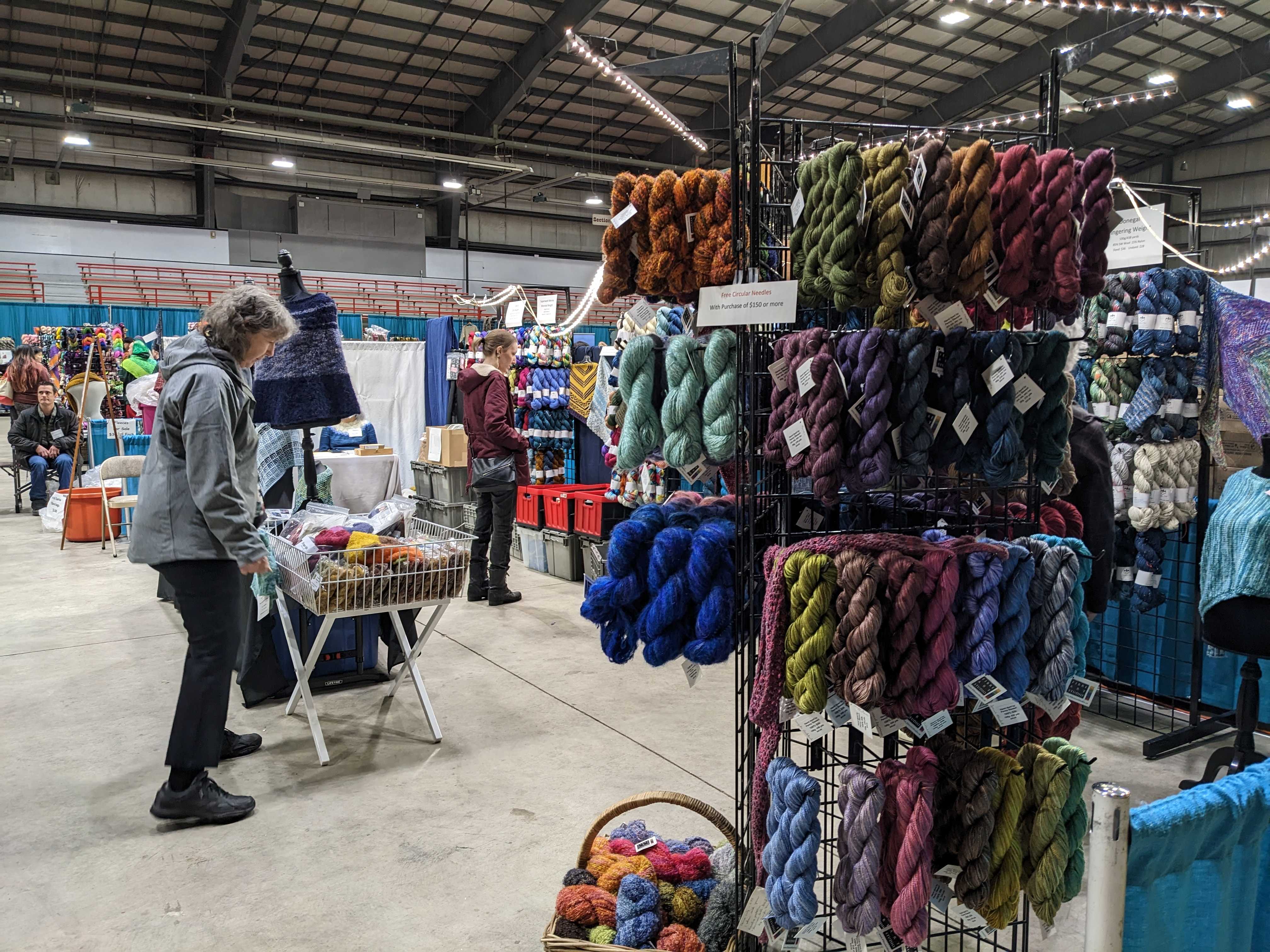
手編み糸も特殊な繊維などの高級品がたくさん。触ってみるだけでうっとりとしてしまうようなもの、手染めの美しい色合い、珍しい繊維との混紡など、盛りだくさんです。それぞれユニークなお店ばかりで、二日間かけて巡っても足りないくらいです。
Hand-knitted yarns also include many high-end products such as rare fibres. There are plenty to choose from, including those ones to swoon for, beautiful hand-dyed colours and blends with unusual fibres. Each shop is so unique that a two-day tour would not be enough to check everything out.
私は手紡ぎの実演のボランティアで参加しました。もちろん買い物もしましたが、最近引っ越して、荷解きしながら毛糸や羊毛を整理していてびっくり。いくら整理してもまだまだある。これはあと100年くらい生きないと使いきれないのでは?というくらいあるのです。それこそお店開けるみたいにある。だから、地元の農場主をサポートするために、ということで、知り合いのお店から少しだけ買うにとどめました。
I volunteered to take part in a hand-spinning demonstration. Of course, I did some shopping. However, I had recently moved and was unpacking and sorting through my yarns and wools, I was surprised to find out how much wool stash I had. No matter how much I sorted out, there is still more. I thought I would have to live for another 100 years or so to be able to use it all up. It's so much I could open a shop!
So I limited myself to buying a little bit from the vendors I knew, to support the local farmers.
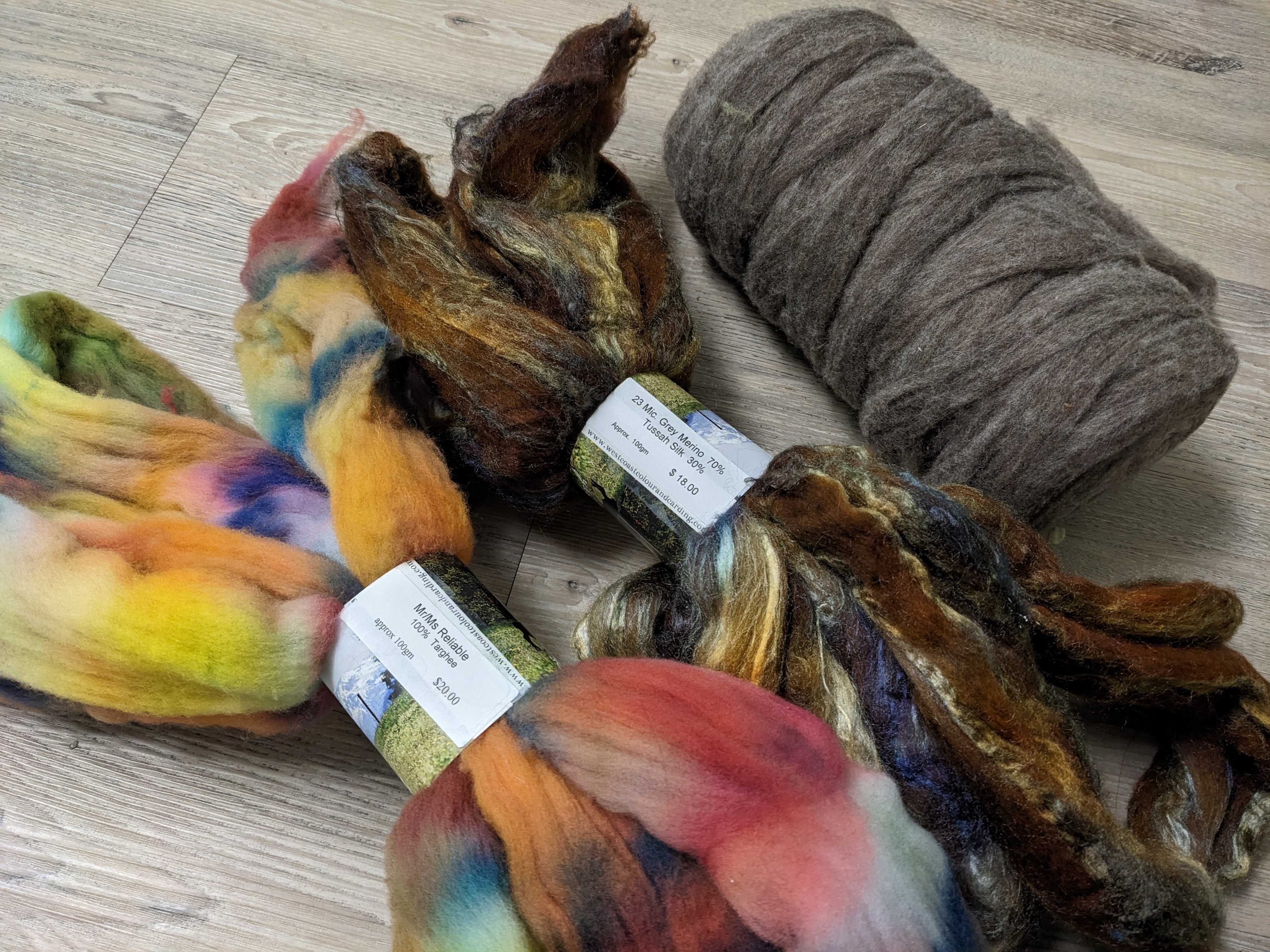
どれも100gです。高いかな。
このお店の人は元うちのギルド(愛好会みたいなものですが、一般向けの啓蒙とか教育とかも目標としているもので、趣味よりはもうちょっと上を行く人たちが集まっています。セミプロみたいな感じ)のメンバーでしたが、看護師の本職を引退したあとに、自宅で飼っていた5頭の羊たちとともに田舎の方へ引っ越して、現在50頭以上の大きな農場を経営している染色家です。
The lady in the shop was a former member of our guild, she is a dyer who retired from her day job as a nurse and moved to the countryside with her five sheep at home and now runs a big farm with over 50 sheep.
一番上のグレーのは「うちのベイビーのよ」と言ったので、試しに買ってみました。20ドルくらい。2000円くらいですね。真ん中のはメリノ羊の毛とシルクを合わせて染めたもの。下はアメリカ産のターギーという羊の毛で、これがものすごく弾力があってふかふかで、しかも柔らかく、繊維の長さもメリノよりは長くて紡ぎやすい。今のところ私が一番気に入っている品種です。
The top grey one is her baby's, so I bought it to try, for about $20, which is about ¥2,000.
The middle one is a combination of merino sheep's wool and silk dyed together.
The bottom one is from an American Targhee sheep, which is very resilient and fluffy and soft. Its staple is also longer than merino, making it easier to spin. It is my favourite variety at the moment.
I tend to buy blue or green ones, so this time I bought one in somewhat different colours.
お気に入りの記事を「いいね!」で応援しよう
[ファイバーアート・手紡ぎ・手織り] カテゴリの最新記事
-
小さな織り機 Little Looms 2024年01月28日 コメント(2)
-
イヤフォンポーチ Earbud Pouches 2023年03月23日
ほふふです、ここでいいんですよね?
ほふふ さん
よくわからないんだけどね、猫まんなさんがギルドの掲示板に書かれているAmazonどうのこうのというの、それがNiftyに関係あるの?
03エラーでちょっと検索してみたけど、
サイトへの一時的なアクセスの集中も403エラーが発生する原因というのがありました。
CloudFrontの403エラーについてはAmazonのところで検索したら
CloudFrontの403エラーの原因は?
エラーは、署名付き URL または署名付き Cookie の設定が原因です
というのがでてました。
Amazonの方はわからないけど、ひつじ村の方は多分だけ今回のことはアクセスが集中したからじゃないのかなあ。
甘い予測だけど、たぶん、これからも普通にひつじ村続けられると思うんだけど、だめなのかなあ。
あと、猫まんなさんが、ギルドの掲示板に書かれた
Amazon CloudFronがお住まいの国からのアクセスをブロックしています、で検索したら
特定の国からのアクセスをブロックするには、[ブロックリスト] を選択します。 [国] で、許可またはブロックする国を選択します。次に、[追加] を選択します。 [変更 ...
というのとか
CloudFrontでアクセス制限する国は? という質問があって、それの回答が
CloudFrontでアクセス制限する国は?
解決策
CloudFront コンソールを開きます。
地域制限を適用するディストリビューションを選択します。
[地理的制限] タブを選択します。
[編集] を選択します。
各国からのアクセスを許可するには、[制限タイプ] で [許可リスト] を選択します。 ...
[国] で、許可またはブロックする国を選択します。
とか出てました。
全く素人なのでよくわからないけど国の制限とか解除自分でできる?
と思ってしまいました。違っていたらごめんなさい。
ただ、ひつじ村や横丁はメンテの後でアクセスが集中しててつながりにくくなっていただけじゃないかと……甘いい考えかもしれませんが。
ただ、今まで不通にゲームできていて、急にできなくなったのであればひつじ村のサポートに問い合わせたら何とかなるような気がします。
せんべやさんも書いていたけど、メンテの後ゲームステーションにログインするとき、いまだに、え? と思うくらい時間がかかります。
だから、猫まんなさんが続けたいと思われるのなら、あきらめずに、ひつじ村絵のログインこの後も試してみてください。そして駄目だった時はとりあえずサポートに連絡を。 (2024年01月25日 12時32分08秒)
03エラーでちょっと検索してみたけど、
サイトへの一時的なアクセスの集中も403エラーが発生する原因というのがありました。
CloudFrontの403エラーについてはAmazonのところで検索したら
CloudFrontの403エラーの原因は?
エラーは、署名付き URL または署名付き Cookie の設定が原因です
というのがでてました。
Amazonの方はわからないけど、ひつじ村の方は多分だけ今回のことはアクセスが集中したからじゃないのかなあ。
甘い予測だけど、たぶん、これからも普通にひつじ村続けられると思うんだけど、だめなのかなあ。
あと、猫まんなさんが、ギルドの掲示板に書かれた
Amazon CloudFronがお住まいの国からのアクセスをブロックしています、で検索したら
特定の国からのアクセスをブロックするには、[ブロックリスト] を選択します。 [国] で、許可またはブロックする国を選択します。次に、[追加] を選択します。 [変更 ...
というのとか
CloudFrontでアクセス制限する国は? という質問があって、それの回答が
CloudFrontでアクセス制限する国は?
解決策
CloudFront コンソールを開きます。
地域制限を適用するディストリビューションを選択します。
[地理的制限] タブを選択します。
[編集] を選択します。
各国からのアクセスを許可するには、[制限タイプ] で [許可リスト] を選択します。 ...
[国] で、許可またはブロックする国を選択します。
とか出てました。
全く素人なのでよくわからないけど国の制限とか解除自分でできる?
と思ってしまいました。違っていたらごめんなさい。
ただ、ひつじ村や横丁はメンテの後でアクセスが集中しててつながりにくくなっていただけじゃないかと……甘いい考えかもしれませんが。
ただ、今まで不通にゲームできていて、急にできなくなったのであればひつじ村のサポートに問い合わせたら何とかなるような気がします。
せんべやさんも書いていたけど、メンテの後ゲームステーションにログインするとき、いまだに、え? と思うくらい時間がかかります。
だから、猫まんなさんが続けたいと思われるのなら、あきらめずに、ひつじ村絵のログインこの後も試してみてください。そして駄目だった時はとりあえずサポートに連絡を。 (2024年01月25日 12時32分08秒)
訂正です、たぶんまだ他に一杯あると
ほふふ さん
長々とごめんなさい、何度も
ほふふ さん
後もう1個、こちらのブログを探すときに「猫まんなのもこもこ手つなぎワールド」というので検索したら、一番上に「猫漫画のもこもも手つなぎワールド」ではないですか? というのが出ました^^
おもしろそうなのでどんなのか見ようとクリックしたら、表示されませんでした、だったらそんなの出さないで、と思った^^
可愛い猫が見えると思ったのに^^ (2024年01月25日 12時45分18秒)
おもしろそうなのでどんなのか見ようとクリックしたら、表示されませんでした、だったらそんなの出さないで、と思った^^
可愛い猫が見えると思ったのに^^ (2024年01月25日 12時45分18秒)
Re:ほふふです、ここでいいんですよね?(03/31)
猫まんな/てぬきねこ
さん
ほふふさんへほふふさんへ
もしかしたら一時的なものだったかもしれませんね。
それにしても、イベント終了前数時間ってねえ。
携帯からはひつじ村はダメだったんですが、横丁の方はできてたんですよ。つぶやきは見られないんですが。アプリがあって使えたの。それが使えなくなっていました。
昨日の夜から丸一日たってもダメだったので、今回のイベントはおじゃんです。頑張ったのになあ。
今(日本時間で4時ちょっとすぎ)トライしてみましたが、同じですね。入れません。
いつまで入れないのかわからないですが、この機会にしばらく休憩しようかと思ってます。毛糸いじってブログ書いていこうかな、と思うのです。
ゲームステーションの方、定期的にチェックしていきますけどね。
(2024年01月25日 16時16分03秒)
もしかしたら一時的なものだったかもしれませんね。
それにしても、イベント終了前数時間ってねえ。
携帯からはひつじ村はダメだったんですが、横丁の方はできてたんですよ。つぶやきは見られないんですが。アプリがあって使えたの。それが使えなくなっていました。
昨日の夜から丸一日たってもダメだったので、今回のイベントはおじゃんです。頑張ったのになあ。
今(日本時間で4時ちょっとすぎ)トライしてみましたが、同じですね。入れません。
いつまで入れないのかわからないですが、この機会にしばらく休憩しようかと思ってます。毛糸いじってブログ書いていこうかな、と思うのです。
ゲームステーションの方、定期的にチェックしていきますけどね。
(2024年01月25日 16時16分03秒)
Re:長々とごめんなさい、何度も(03/31)
猫まんな/てぬきねこ
さん
ほふふさんへ
猫漫画、私が検索したときも出ました。何だか面白いですよね。「手紡ぎ」もあまり馴染みのない言葉だからか、いろいろとバージョンがありますよ。鉄麦とかも!めちゃ硬そうw
「猫まんな」も、猫まんま、猫マンな、寝込まんななど。
もともと、ねこまんまと書こうとして、打ち間違えてまんなになったのを、これの方がユニークでいいじゃん、というだけのことで決めたハンドルですから。
以前は料理の記事だったので、「てぬきねこ」でした。雑誌にレシピを載せていたのですが、本職の料理研究家とか調理師の資格があるとかではなかったので、本名は出させてくれなかったの。あくまでも雑誌編集のスタッフが書いたもの、ということにしたかったんでしょうね。だからこれは私のキャリアとかにはならないのですが、ブログ開設はほぼ20年くらい前だと思うから、その頃のネット事情も今とは違ったと思います。もちろん、その雑誌も当時はネット上では見られませんでした。今は過去10年間のなら見られます。でももう私は記事書いてないですが。
「月刊ふれいざー」で検索すると出てきます。大学の先輩が一人でやってます。すごい人なのよ。彼女とは大学だけでなく学部まで同じですが、カナダに来て卒業生の会で知り合ったのでした。 (2024年01月25日 16時29分51秒)
猫漫画、私が検索したときも出ました。何だか面白いですよね。「手紡ぎ」もあまり馴染みのない言葉だからか、いろいろとバージョンがありますよ。鉄麦とかも!めちゃ硬そうw
「猫まんな」も、猫まんま、猫マンな、寝込まんななど。
もともと、ねこまんまと書こうとして、打ち間違えてまんなになったのを、これの方がユニークでいいじゃん、というだけのことで決めたハンドルですから。
以前は料理の記事だったので、「てぬきねこ」でした。雑誌にレシピを載せていたのですが、本職の料理研究家とか調理師の資格があるとかではなかったので、本名は出させてくれなかったの。あくまでも雑誌編集のスタッフが書いたもの、ということにしたかったんでしょうね。だからこれは私のキャリアとかにはならないのですが、ブログ開設はほぼ20年くらい前だと思うから、その頃のネット事情も今とは違ったと思います。もちろん、その雑誌も当時はネット上では見られませんでした。今は過去10年間のなら見られます。でももう私は記事書いてないですが。
「月刊ふれいざー」で検索すると出てきます。大学の先輩が一人でやってます。すごい人なのよ。彼女とは大学だけでなく学部まで同じですが、カナダに来て卒業生の会で知り合ったのでした。 (2024年01月25日 16時29分51秒)
右の顔選択って何だろう^^ → → → →これ→
ほふふ さん
猫まんな/てぬきねこさんへ
お鍋のイベントが終わって、もうメンテは終わっているだろうと次のギルド戦のイベントのため3時半ごろだったかなログインしようとしたらまたログイン画面から次の画面に映るまで時間が結構かかって、あ、やっと次の画面に変わったと思ったらエラーが出てるとかメンテ中(ゲームステーションの方の)だとかが出てひつじ村どころかゲームステーションにすらたどりつけませんでした。
何度かトライして、同じ状態で、ああもう駄目だと最後にもう一度と思ってログインしようとしたらまた同じようにログイン画面から抜けるのに時間がかかって、もうこのまま放置だとパソの前を離れてしばらくして戻ってきたらこれで駄目だったゲームステーションの画面になっていました。
それでなんとか今回のイベントで、オリーブを育ててます。
でも、お鍋の方でAP回復薬使ってしまって少ししか残っていないので、今回はあまりイベント進められそうにないです。
猫まんなさんが戻ってこれることを祈りながら、これでパソの電源落として、寝ます。おやすみなさい。 (2024年01月26日 00時15分17秒)
お鍋のイベントが終わって、もうメンテは終わっているだろうと次のギルド戦のイベントのため3時半ごろだったかなログインしようとしたらまたログイン画面から次の画面に映るまで時間が結構かかって、あ、やっと次の画面に変わったと思ったらエラーが出てるとかメンテ中(ゲームステーションの方の)だとかが出てひつじ村どころかゲームステーションにすらたどりつけませんでした。
何度かトライして、同じ状態で、ああもう駄目だと最後にもう一度と思ってログインしようとしたらまた同じようにログイン画面から抜けるのに時間がかかって、もうこのまま放置だとパソの前を離れてしばらくして戻ってきたらこれで駄目だったゲームステーションの画面になっていました。
それでなんとか今回のイベントで、オリーブを育ててます。
でも、お鍋の方でAP回復薬使ってしまって少ししか残っていないので、今回はあまりイベント進められそうにないです。
猫まんなさんが戻ってこれることを祈りながら、これでパソの電源落として、寝ます。おやすみなさい。 (2024年01月26日 00時15分17秒)
訂正訂正^^
ほふふ さん
ほふふさんへ
ほふふさんへ
寝ると言ったんだけど、ちょっと抜けているところがあって
これで駄目だった→これで駄目だったらもう諦めようと思っていたら
です。
わたしのほふふもひつじ村やるためにNiftyにと登録した時に適当につけた名前なので今はこんな前付けたことを後悔している^^
では今度こそ寝ます^^ (2024年01月26日 00時24分43秒)
ほふふさんへ
寝ると言ったんだけど、ちょっと抜けているところがあって
これで駄目だった→これで駄目だったらもう諦めようと思っていたら
です。
わたしのほふふもひつじ村やるためにNiftyにと登録した時に適当につけた名前なので今はこんな前付けたことを後悔している^^
では今度こそ寝ます^^ (2024年01月26日 00時24分43秒)
Re:訂正訂正^^(03/31)
猫まんな/てぬきねこ
さん
こんにちは
ほふふ さん
猫まんな/てぬきねこさんへ
猫まんなさんの新しい記事の方にコメント書こうかと思ったのですが。
関係ない内容だし、いやこちらの記事とも関係ない話ですが^^
続けてこちらの方に書きます。
次書くことがあれば新しい記事の方に書くかも、あるいは古い記事の方に^^
では書きます^^
>小さなひつじさんが出てきて頭下げられました
これ↑ね、私もメンテの後(まだ最中だったのかもしれない)行った時に、何度も出ました。
で、しかたがないのでしばらく時間をおいてからログインやり直したらログインできました。
ただ、これが出るということは、混んでなかったり、メンテが終わったらログインできるということじゃないかと。完全にゲームステーションに接続できない状態だったらこれは出ないと思うので。
イベントが始まった直後とかだと、なかなかログインできなかったりするから、空いている時間、と言ってもどのときが空いているかわからないけど、混んでなければログインできるんじゃないかと。
今でもね、ログイン画面があるでしょ、そこのログインするをクリックした後、次の画面、ゲームステーションの画面になるまで時間がかかります。2分なんてざらで3分くらい待たされることもあります、場合によってはもっと。
今日は1分ほどでログインできたけど。
つぶやき欄に書けないという件ですが、ひつじ村の横のつぶやきにPA……という方がご自身のつぶやきに回答してくださった方に返事を書かれていたのですが『もっと見るが見れるけど書き込めなかったので表に書いた』とつぶやかれていました。
表の方というのはたぶん子のつぶやきをつぶやかれたひつじ村の横のつぶやき欄のことだとおもうけど。
他の方も見えるけど、かけないという方がいるんだなあと思いました。
私の場合、ためしにやってみたんですが、文字は打てるんですが送信できるまでは確認できませんでした。何の用もなく知らない方に送信できないので。
(2024年01月27日 10時31分23秒)
猫まんなさんの新しい記事の方にコメント書こうかと思ったのですが。
関係ない内容だし、いやこちらの記事とも関係ない話ですが^^
続けてこちらの方に書きます。
次書くことがあれば新しい記事の方に書くかも、あるいは古い記事の方に^^
では書きます^^
>小さなひつじさんが出てきて頭下げられました
これ↑ね、私もメンテの後(まだ最中だったのかもしれない)行った時に、何度も出ました。
で、しかたがないのでしばらく時間をおいてからログインやり直したらログインできました。
ただ、これが出るということは、混んでなかったり、メンテが終わったらログインできるということじゃないかと。完全にゲームステーションに接続できない状態だったらこれは出ないと思うので。
イベントが始まった直後とかだと、なかなかログインできなかったりするから、空いている時間、と言ってもどのときが空いているかわからないけど、混んでなければログインできるんじゃないかと。
今でもね、ログイン画面があるでしょ、そこのログインするをクリックした後、次の画面、ゲームステーションの画面になるまで時間がかかります。2分なんてざらで3分くらい待たされることもあります、場合によってはもっと。
今日は1分ほどでログインできたけど。
つぶやき欄に書けないという件ですが、ひつじ村の横のつぶやきにPA……という方がご自身のつぶやきに回答してくださった方に返事を書かれていたのですが『もっと見るが見れるけど書き込めなかったので表に書いた』とつぶやかれていました。
表の方というのはたぶん子のつぶやきをつぶやかれたひつじ村の横のつぶやき欄のことだとおもうけど。
他の方も見えるけど、かけないという方がいるんだなあと思いました。
私の場合、ためしにやってみたんですが、文字は打てるんですが送信できるまでは確認できませんでした。何の用もなく知らない方に送信できないので。
(2024年01月27日 10時31分23秒)
Re:こんにちは(03/31)
猫まんな/てぬきねこ
さん
ほふふさんへ
なるべくならゲームの記事の方にコメントをつけてもらえると助かります。ここはもう一年前の記事なので、ここに今からFibres Westの記事についてコメントする人もないかもしれませんが、一応、ゲームの記事はそのためにアップしましたので。
コメントつけて下さったたくねこさんもゲームのことに触れておられますから、関係ないということはないですよ。ただ、楽天内の昔の友人とは、いろいろと積もる話もあるのですよ。
ひつじ村の「もっと見る」は使いにくいとは思っていました。ゲーム画面から飛んでいるのに、再ログインを要求されることがよくあります。それでログインすると、トップページに飛ばされ、「掲示板」、ひつじ村のアイコンをリストから探す(なんと一番下から2番目にある!)、そして「つぶやき」を押してやっと書き込める、なんてことがしょっちゅうです。
横上の方はもっと使いやすくて、再ログインの必要は大抵ないです。「もっと見る」を見ないと、他の人に、質問にお返事いただいてますよ、って注意されることも。
「掲示板」に行くとわかるけど、横丁はリストから探す必要もないくらい新着のつぶやきがあって、しかも雑談スレもたくさんあって、そこからすぐに飛べるから、それも便利。私は雑談スレはあまり見ないですけど。 (2024年01月27日 15時21分00秒)
なるべくならゲームの記事の方にコメントをつけてもらえると助かります。ここはもう一年前の記事なので、ここに今からFibres Westの記事についてコメントする人もないかもしれませんが、一応、ゲームの記事はそのためにアップしましたので。
コメントつけて下さったたくねこさんもゲームのことに触れておられますから、関係ないということはないですよ。ただ、楽天内の昔の友人とは、いろいろと積もる話もあるのですよ。
ひつじ村の「もっと見る」は使いにくいとは思っていました。ゲーム画面から飛んでいるのに、再ログインを要求されることがよくあります。それでログインすると、トップページに飛ばされ、「掲示板」、ひつじ村のアイコンをリストから探す(なんと一番下から2番目にある!)、そして「つぶやき」を押してやっと書き込める、なんてことがしょっちゅうです。
横上の方はもっと使いやすくて、再ログインの必要は大抵ないです。「もっと見る」を見ないと、他の人に、質問にお返事いただいてますよ、って注意されることも。
「掲示板」に行くとわかるけど、横丁はリストから探す必要もないくらい新着のつぶやきがあって、しかも雑談スレもたくさんあって、そこからすぐに飛べるから、それも便利。私は雑談スレはあまり見ないですけど。 (2024年01月27日 15時21分00秒)
わかりました。
ほふふ さん
猫まんな/てぬきねこさんへ
次に書くときはそうしますね。
ということでこの記事へのコメントはこれが最後です。
今、猫まんなさんがおっしゃっていた小さなヒツジと同じ物かどうかわからないけど、ログインしようとゲームを始めるをくりっくしたら、ひつじが誤っている画像と以下の文章が出てログインできません^^
謝っているひつじの絵の下の文字
ページが表示できません。
ただいまエラーが発生しております。
ご迷惑をおかけして申し訳ございません。
時間をおいて、再度アクセスいただきますようお願いいたします。」
ではではお邪魔しました。
(2024年01月27日 16時00分38秒)
次に書くときはそうしますね。
ということでこの記事へのコメントはこれが最後です。
今、猫まんなさんがおっしゃっていた小さなヒツジと同じ物かどうかわからないけど、ログインしようとゲームを始めるをくりっくしたら、ひつじが誤っている画像と以下の文章が出てログインできません^^
謝っているひつじの絵の下の文字
ページが表示できません。
ただいまエラーが発生しております。
ご迷惑をおかけして申し訳ございません。
時間をおいて、再度アクセスいただきますようお願いいたします。」
ではではお邪魔しました。
(2024年01月27日 16時00分38秒)
【毎日開催】
15記事にいいね!で1ポイント
10秒滞在
いいね!
--
/
--

